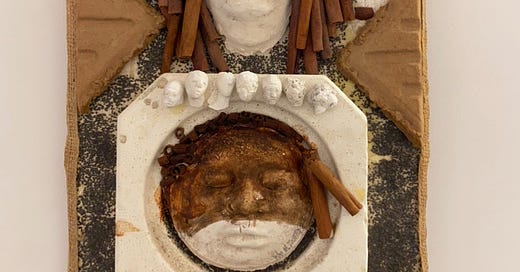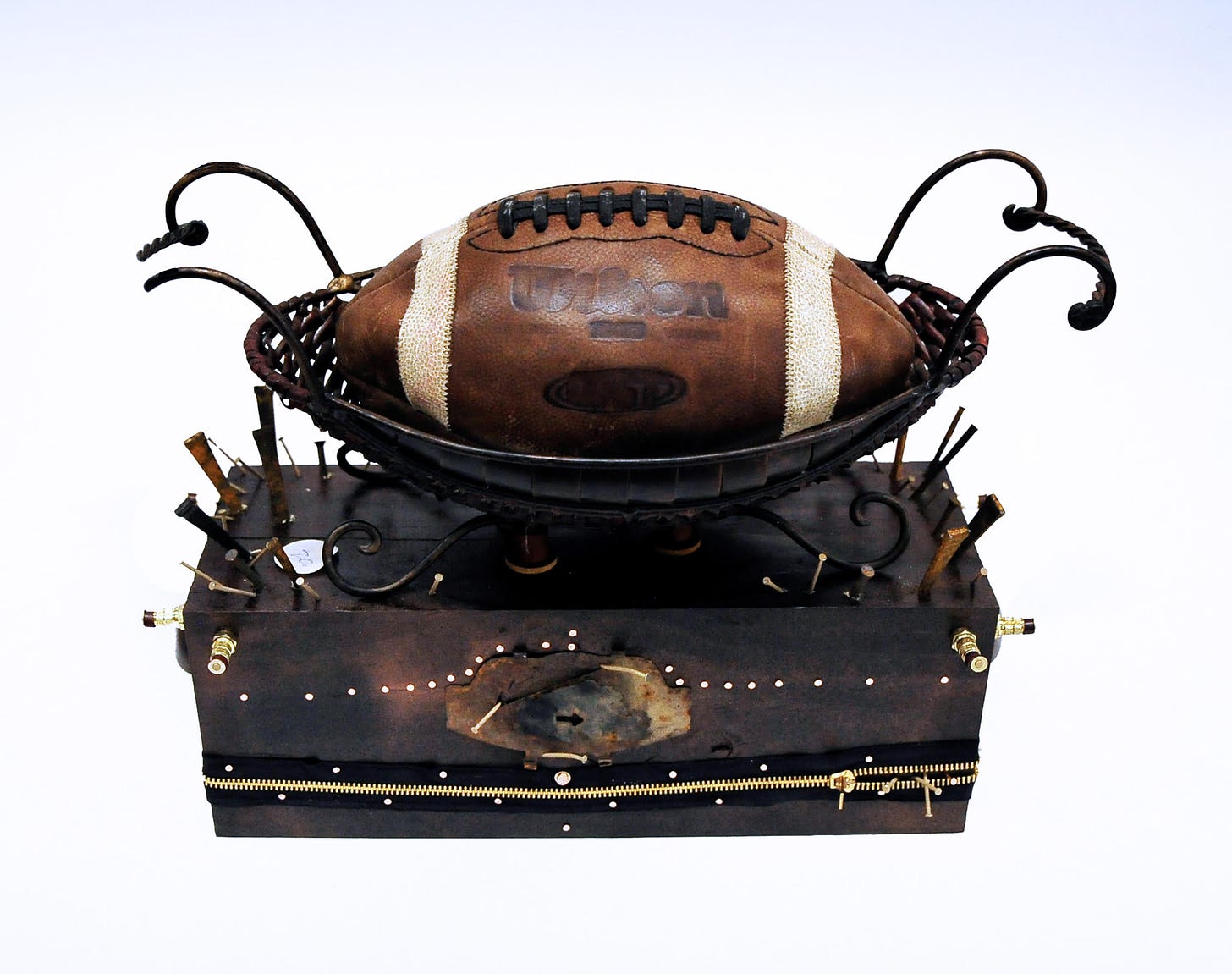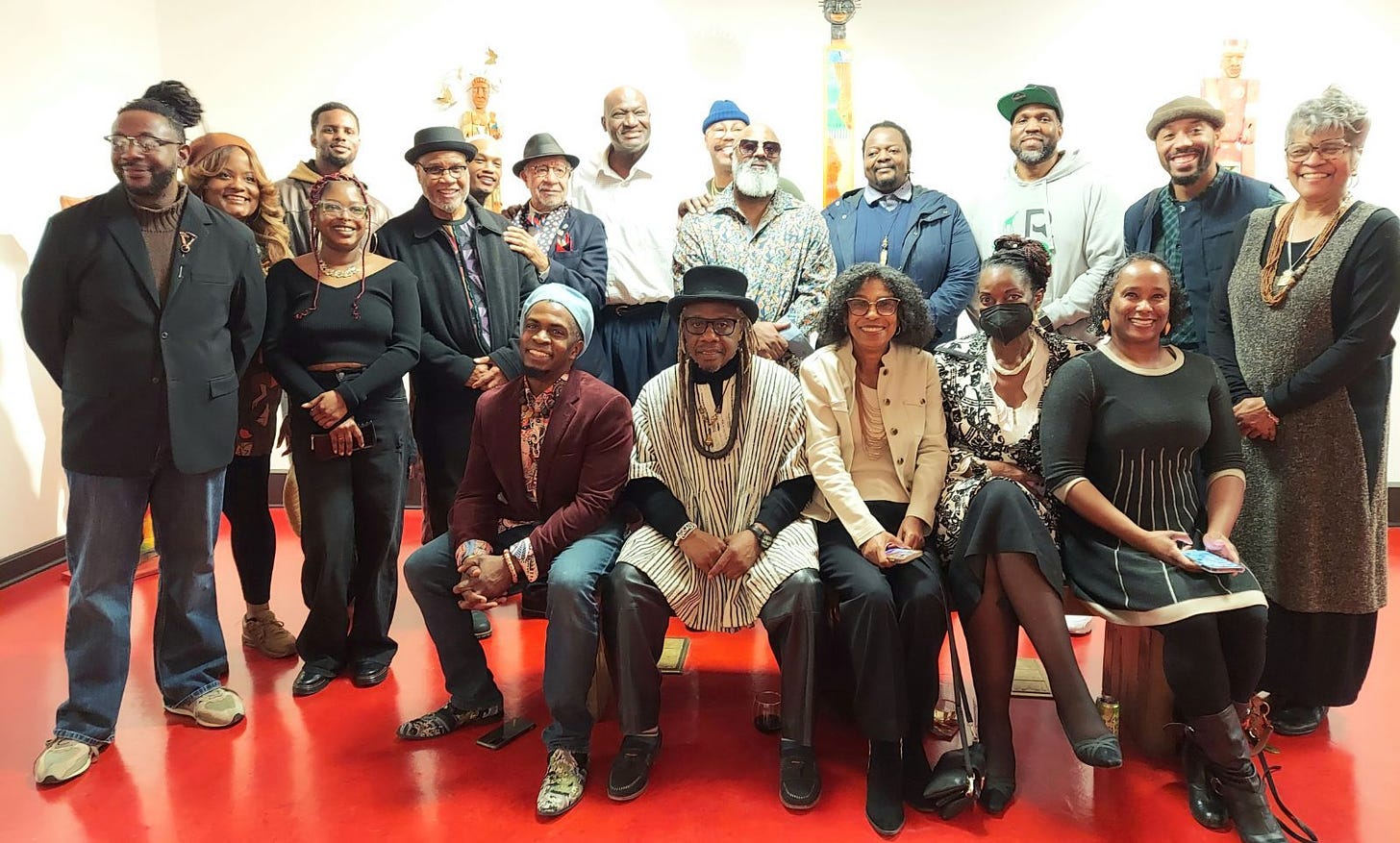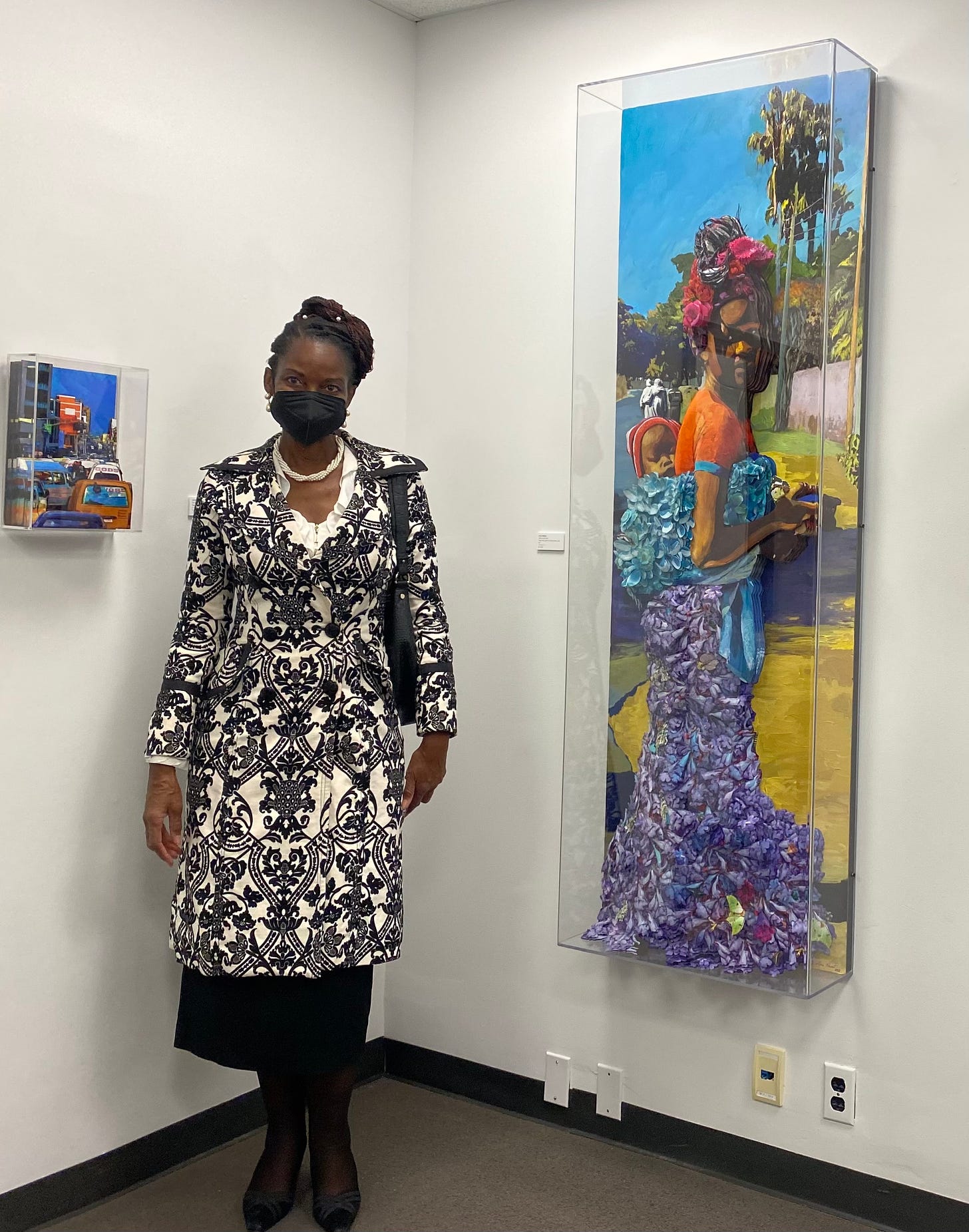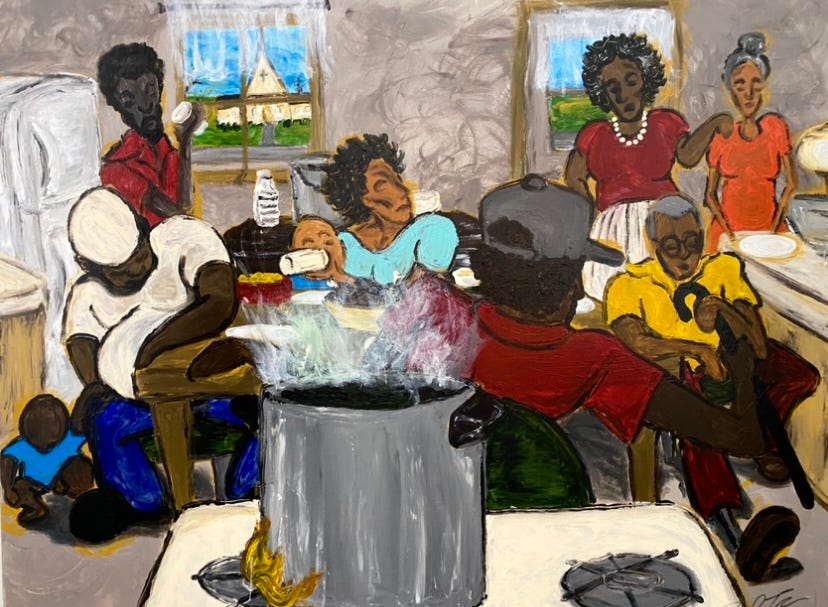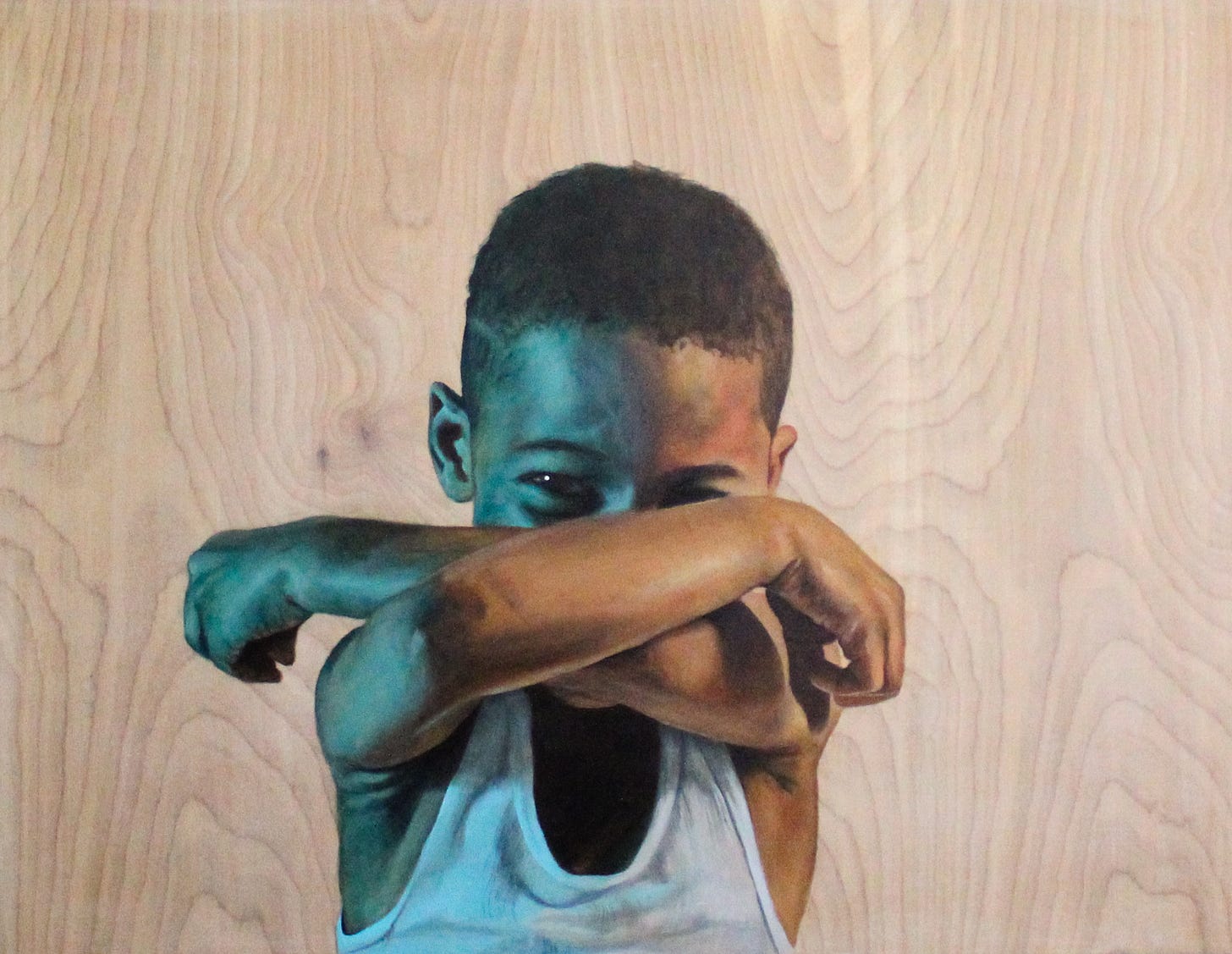Walk into the Moremen Gallery and a collection of faces just inside the door welcomes visitors. In one work, there are flashes of rose and green (similar to patinated copper) and faded images surrounding masks of faces ensconced among wire mesh. On the frame around one face is a snippet of the poem “We Wear the Mask” by the 19th-century native Kentucky writer and former slave Paul Laurence Dunbar.
“Someone To Watch Over Me 3” by William M. Duffy. Image courtesy Moremen Gallery.
Just across from that hangs another mixed-media work with two faces surrounded by burlap, cardboard, and a few mask coverings that have become so common since the outbreak of the pandemic, that overly a few small syringes. One face is above the other which is in a frame with an abstract hand seemingly supporting that frame.
The first work by Ed Hamilton, “We Wear the Mask,” and the second, William M. Duffy’s “Someone to Watch Over Me 3,” is just the beginning of “Perspectives 2023,” an exhibit showing more than 100 works by more than 30 Black artists from throughout the region and running through Jan. 28.
Hamilton’s and Duffy’s works illustrate unexpected incorporation into this show, given their works here don’t align with what most would find familiar in their large sculptures.
Likewise, there is much that surprises in this massive exploration of Black identity and life filling the nearly ten spaces in the gallery and overflowing into an adjacent room with a range of media — from pastel and pencil drawings to sculptures of walnut and limestone to film. While the works express a range of emotions and touch on various histories, the works are primarily grouped according to artist rather than any theme. Together, they depict snippets of life imbued with joy, longing, heartache, history and the talent of Black artists in our region ranging across generations.
“Colin Kaepernick, George Floyd Knee Cushion #16” by Bing Davis. Image courtesy Moremen Gallery.
“Perspectives 2023” is a milepost, coming after the pandemic erupted in 2020 and more attention has turned to some of Louisville’s Black artists. A handful have had their work in exhibits at The Speed Art Museum and others in various regional gallery shows. The museum’s landmark 2021 “Promise, Witness, Remembrance” exhibit spotlighting Amy Sherald’s portrait of Breonna Taylor also held works by local artists including a sculpture by Hamilton, a print work by Noel W. Anderson and photographs by Jon Cherry.
Before Covid emerged and the killings of Black people by police, including Louisville’s own Taylor, sparked nationwide protests, Louisville’s stronghold locations for Black art were Louisville’s African-American owned and focused E&S Gallery and the annual juried African American Art Exhibition that Actors Theatre of Louisville had hosted for 26 years. (Actors Theatre of Louisville has not brought the exhibit back since 2020.)
In part, that exhibit was an inspiration for the ambition and breadth of the work in “Perspectives 2023,” said Gallery owner Susan Moremen. The endeavor to curate “Perspectives 2023” started about a year ago with collaborators with artists Duffy, Hamilton, Sandra Charles and Gwendolyn Kelly.
Many of the artists whose work is in “Perspectives 2024.” Photo courtesy Moremen Gallery.
Joy • Joy is evident at nearly every corner and Charles makes her contribution with the portrait “Your Wall, a Dance, Jabani” displaying a dancing woman and emanating such bliss you think you think you can hear the music playing. Nearby, is one of the exhibit’s strongest examples of joy, Ton'nea Green’s “Sparkle 'n Glow.” This young self-taught artist depicts a coy and grinning boy in acrylic on birchwood with his arms crossed over most of his face save for his right eye peeking over his elbow. His eye gleams as it looks straight at the viewer. The intimate painting radiates connection, play and hope with no hint of artificiality.
Identity + Power • Other works play with media and portraiture in elaborate colors and practices, such as “Nat,” the large and colorful mixed-media sculpture of another dancer, this one a man. His arm is outstretched above his head and his leg is turned out. His hand and foot are larger than the rest of his body. This dancer is making his mark and planting joy. “Nat” is just one of many works that fill a room by artist Lavon Williams, who was a sophomore on the University of Kentucky’s 1978 NCAA championship team and later played professionally in Italy and Japan.
Licia Priest’s with her work “Mother and Child.” Photo courtesy Moremen Gallery.
In another room, Licia Priest’s opulent standout “Mother and Child” echoes the power of motherhood and fertility using painting, photography and gold leaf on paper tole — a process of creating three-dimensional pictures by layering multiple cut-out sections of the same image. The African mother is enveloped in a landscape of vibrant color where she looks at the viewer with a baby wrapped tightly to her back in a kanga (a large cloth). But Priest adds to the magic of the image through the painting and through the paper tole adorning the mother’s skirt and kanga in abundant delicate flowers that spring with life from the surface.
Family Life • The significance of family home life and domestic history — what it has been over different eras — surfaces in many works, particularly those of Mark Priest and Darryl Tucker. While both use acrylic, their approaches are vastly different. Mark Priest’s work continues a classical tradition with an emphasis on form and proportion along with subtle tones and dark colors. This is evident in his painting “There's Your Mother Now!” It is part of his series exploring the lives of slaves and the Underground Railroad. In this foreboding scene, a large and dominant white man near the house’s threshold points inside towards a small Black woman while two small children stand in between the adults. Just outside is a wagon of some kind.
“Sunday Dinner Over Grandmas After Church,” an acrylic painting by Darryl Tucker. Image courtesy Moremen Gallery.
Darryl Tucker, who uses his fingers in painting with acrylic, works in colors so bright they sometimes border on fluorescent. A scene of a family with the viewer given a spot just behind the kitchen stove presents a family closer to modern times in “Sunday Dinner Over Grandmas After Church.” Just beyond the large pot belching steam in the foreground, multiple generations are packed into a kitchen with adults juggling babies while the sun shines in from a few windows.
Drawing on History • The private becomes public where artists use history as inspiration. North Carolina artist Pinkie Strother does this beautifully in her sprawling “Top Hat Diorama” which pays homage to Louisville’s famed Top Hat nightclub that was located on Walnut (now Muhammed Ali Boulevard) and 13th streets and featured jazz greats including Ella Fitzgerald. In Strother’s sweeping scene musicians play their instruments (piano, trumpet, saxophone), and dancers are frozen in time. Patrons are seated at tables and the bar and, of course, furnished with tiny cocktails.
“Winners Circle” references racing and its ties to Black history in one of several distinctive mixed-media collages in this show by the Kentucky artist who goes by Dafri (Jason Thompson). One work appears to lionize 19th-century jockey Isaac Burns Murphy, a rider in 11 Kentucky Derbys and winner of three. An ornate frame highlights the cut-out of the side profile of his face like a mane, and from his colorful cut-out print shirt emerges a cut-out of an enlarged black-and-white hand giving support to the frame.
“Sparkle ‘n Glow” by Ton’nea Green. Image courtesy Moremen Gallery.
Ed White’s mixed-media sculpture “Jomo Kenyatta” looks further afield in referencing history. The sculpture, a reference to the anti-colonial activist and Kenya’s first president, sits in the space with Hamilton’s and Duffy’s work. White, a co-founder and long-time leader of The River City Drum Corp, retired in 2019 and turned his attention to artmaking. White’s piece depicts the man unlike any of his photos but presents a solid sense of strength showing a leader with dreadlocks and other markings found on African masks. The addition creates a three-point journey among the works with their nods to portraiture and sources of identity that sweep from East Africa to reach into Kentucky and our own country’s historical repression of Black people.
Symbolism + Abstraction • Some works use even more symbolism to reference history. A piece by artist Bing Davis of Dayton does that by conjuring ideas about multiple histories and contributes a stunning statement with his “Colin Kaepernick, George Floyd Knee Cushion.” It’s made up of several components. At the foundation is a box tightly wrapped in dark material and embellished with a rusted keyhole plate and an encircling zipper while steel nails pierce it from the outside. A glance could identify it as a memory box or torture device like a mini-iron maiden. Atop sits a football, not fully inflated above the nails, in a basket adorned with metal spirals. This piece echoes pain and a resolve to persevere while speaking to the history of the past decade and to slavery. It’s not clear if this Wilson football gives respite from pain and assault, it does signal the importance of taking note of history.
"Pathways" by Floyd Grace III (left) hangs adjacent to Michael Coppage’s "Lot #13." Photo courtesy Moremen Gallery.
A nod to history, nature, genetics and art are entwined in Michael Coppage’s fascinating depiction of an auction with not people but what appear to be White-faced Capuchin monkeys from Central and South America. In this massive oil painting called “Lot #13” at one end a creature holds a paddle to make a bid among an audience of others. On the other, another plays the role of auctioneer at a podium. In between, two hold a golden frame that holds the image of a vast ocean and sky. Beyond the image are the various applications of brushstrokes here that help to create an intriguing world. Moremen has added to the astonishing image by hanging two large works by Cincinnati artist Floyd Grace III on adjacent walls that use a black-and-white palette. Are these abstract works exploding galaxies or flowers? In any case, their undeniable beauty and explosive nature complement Coppage’s painting.
While many more works complete this exhibit, Moreman’s effort to organize such a wide-ranging show and bring regional Black artists to the consciousness of wider public audiences has been no small feat. It also holds so much promise if it is to become an annual event and give the public the chance to see so many artists, multiple perspectives and a range of talent and expression in one place. The ripple effects could lead to greater awareness and discussion about regional Black art and the perspectives they present.
Elizabeth Kramer, a multimedia journalist, has worked for newspapers and public radio, and now leads Arts Angle Vantage, a youth arts journalism program. Never miss an update. She is on Facebook at Elizabeth Kramer – Arts Writer, on Instagram at @artsbureau and on X @arts_bureau.
"Perspectives 2023"
Through Jan. 27
Moreman Gallery
710 W. Main St., 2nd Floor
Louisville, KY 40202
Regular gallery hours: Wednesdays through Saturdays noon to 4 p.m., or scheduled by calling 502-727-3909.
For more information: moremengallery.com

